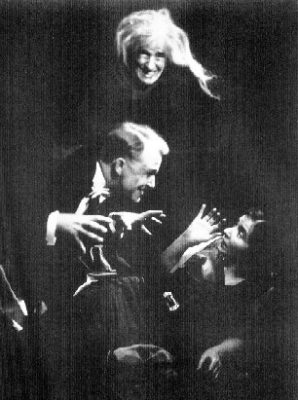
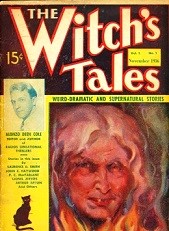 The Witch’s Tale (1931-38) aired “Rats in a Trap” on May 16, 1932, though there is doubt about the precise date, many of the episodes being destroyed by the show’s creator Alonzo Deen Cole (1897-1971) who believed them to be of no commercial value. A scant 54 episodes are known to still exist of the estimated 320+ produced (although this number varies too), and only a third of those remaining 54 are from the US series, the remainder coming from the Australian airings (1938-43). This is only the fourth episode of The Witch’s Tale we have showcased, the first being 14 years ago on October 31, 2009, with the third coming on October 29, 2022. The show has a fascinating history, the highlights being that the show was the first all-original horror series on radio, and it was the first to introduce a narrator for an on-going series, that of “Old Nancy.” Old Nancy’s influence paved the way for other radio narrators such as Raymond of Inner Sanctum fame, and Bill Gaines, of the legendary EC Comics who took Cole’s witch “Old Nancy” as the idea for the Old Witch in his horror comic The Haunt of Fear, for yet another example. And how can we forget the Crypt Keeper from television’s excellent series Tales from the Crypt? All owe a debt to Alonzo Deen Cole’s The Witch’s Tale and Old Nancy.
The Witch’s Tale (1931-38) aired “Rats in a Trap” on May 16, 1932, though there is doubt about the precise date, many of the episodes being destroyed by the show’s creator Alonzo Deen Cole (1897-1971) who believed them to be of no commercial value. A scant 54 episodes are known to still exist of the estimated 320+ produced (although this number varies too), and only a third of those remaining 54 are from the US series, the remainder coming from the Australian airings (1938-43). This is only the fourth episode of The Witch’s Tale we have showcased, the first being 14 years ago on October 31, 2009, with the third coming on October 29, 2022. The show has a fascinating history, the highlights being that the show was the first all-original horror series on radio, and it was the first to introduce a narrator for an on-going series, that of “Old Nancy.” Old Nancy’s influence paved the way for other radio narrators such as Raymond of Inner Sanctum fame, and Bill Gaines, of the legendary EC Comics who took Cole’s witch “Old Nancy” as the idea for the Old Witch in his horror comic The Haunt of Fear, for yet another example. And how can we forget the Crypt Keeper from television’s excellent series Tales from the Crypt? All owe a debt to Alonzo Deen Cole’s The Witch’s Tale and Old Nancy.
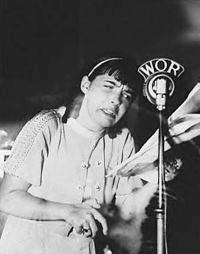
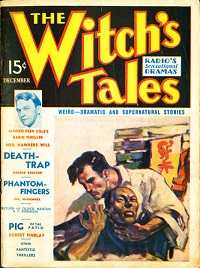 The radio series, usually airing at midnight, proved popular enough that a magazine with the slightly altered title of The Witch’s Tales, saw its first issue with the November 1936 issue (cover top left). Unfortunately, due to magazine publishing inexperience and lack of cross media advertising (there were no ads for the radio show in the magazine, and vice versa), the magazine folded with its second issue dated December 1936 (cover at left) The photo top right is a 1930 publicity shot featuring Cole menacing his wife Marie, with the original Old Nancy, Adelaide Fitz-Allen lurking above. Fitz-Allen was the voice of Old Nancy until her death at age 79 in 1935, at which point a 13-year old Miriam Wolfe (1935 photo at right) would shock Cole with her Old Nancy impression and was hired on the spot. Wolfe would go on to have an impressive career in radio, Broadway, and other endeavors, gaining the respect and accolades of her peers.
The radio series, usually airing at midnight, proved popular enough that a magazine with the slightly altered title of The Witch’s Tales, saw its first issue with the November 1936 issue (cover top left). Unfortunately, due to magazine publishing inexperience and lack of cross media advertising (there were no ads for the radio show in the magazine, and vice versa), the magazine folded with its second issue dated December 1936 (cover at left) The photo top right is a 1930 publicity shot featuring Cole menacing his wife Marie, with the original Old Nancy, Adelaide Fitz-Allen lurking above. Fitz-Allen was the voice of Old Nancy until her death at age 79 in 1935, at which point a 13-year old Miriam Wolfe (1935 photo at right) would shock Cole with her Old Nancy impression and was hired on the spot. Wolfe would go on to have an impressive career in radio, Broadway, and other endeavors, gaining the respect and accolades of her peers.
“Rats in a Trap” is a genuinely fiendish story, more than apropos for Halloween. In fact, it might prove a little overpowering for those born with a particularly vivid imagination coupled with a less than stalwart emotional constitution—especially select scenes in the final third of this perhaps overly graphically depicted tale. The story opens innocently enough, with an up and coming attorney receiving a phone call from his wife, who is at home. The story turns dark almost immediately, however, for the wife is hysterical. Three men have tried to break into their home, and while she has held them off by shooting at them with the couple’s handgun, she is down to the last bullet and can hear the burglars making one last try in breaking into their home. Feeling like a rat in a trap and fearing what the angered and desperate gang might do to her as they have now finally broken into her home, she decides to take her own life using the last bullet in the gun. Needless to say, not only is our lawyer husband shocked beyond belief but so are we at such a horrendous start to this story. Sometimes the less said the better, and this is one of those cases. Suffice it to say that the rest of the story takes place years down the road, and slowly but surely the bereaved attorney plots his revenge with great patience (mere justice is out of the question). But when it finally comes to fruition it becomes one of the most psychologically and physically torturous punishments we can remember, giving the title a whole new meaning, one more than fitting for this ghoulish Halloween story.
Play Time: 23:23
{“Rats in a Trap” aired at midnight on a Monday. At least one of the neighborhood gang stayed up late enough to hear the whole thing, and he led the gang to the nearby newsstand the next afternoon after school to seek out more dark tales like this one from The Witch’s Tale. Astounding Stories (1930-present, now Analog) was definitely more space opera and adventure than it was dark fare, but was already a must buy for the gang. The cover story by Nat Schachner was a novelette titled “Pirates of the Gorm.” Schachner was one of the early SF pulp writers who appeared in quite a few magazines throughout the 1930s, and not all of them in the SF genre. Schachner also wrote a handful of political non-fiction books, including biographies of Aaron Burr and Thomas Jefferson. Another tome that stuck out to me given the current war between the terrorist organization Hamas and the state of Israel was The Price of Liberty: A History of the American Jewish Committee, published in 1948, the same year in which the nation of Israel was born. I find it interesting to learn what other interests writers hold outside of the SF genre, and discovering Schachner’s came as a pleasant coincidence. Astounding held to a monthly schedule for its first 6 issues, then ended 1932 with a pair of bi-monthly issues. The Shadow (1931-49) was on the rise in 1932 and would become one of the most popular single character pulps of all time, with rival magazines springing up in an attempt to cash in on the hero’s firm grasp on the country’s male youth. It was a monthly in 1932. Weird Tales (1923-54) became known as “the unique magazine,” and would publish the best of the dark, the otherworldly, and the macabre supernatural story by the crème de la crème of the genre’s authors, a few of which are featured on the cover below: Hugh B. Cave, Seabury Quinn, Robert E. Howard (!), Edmond Hamilton, Clark Ashton Smith, and two others. That lineup would amaze for any Halloween issue of any dark fantasy or horror magazine, but Weird Tales provided issues like the one below on a regular basis at any time of any year. It was a monthly in 1932.}
[Left: Astounding, May 1932 – Center: The Shadow, May 1932 – Right: Weird Tales, May 1932]
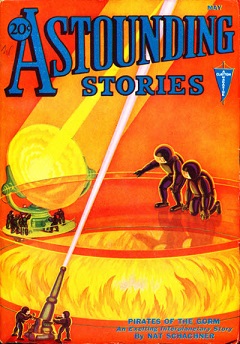
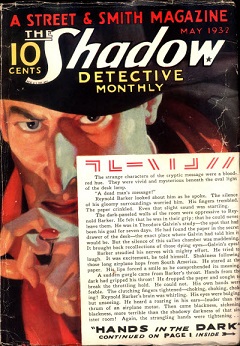
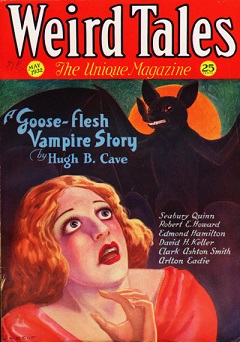
To view the entire list of weekly Old Time Radio episodes at Tangent Online, click here.